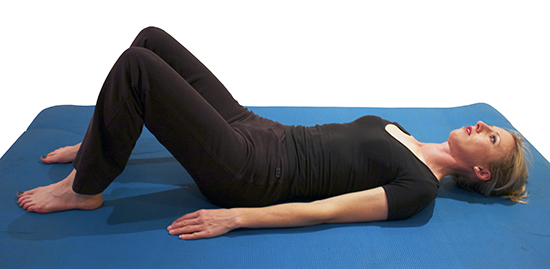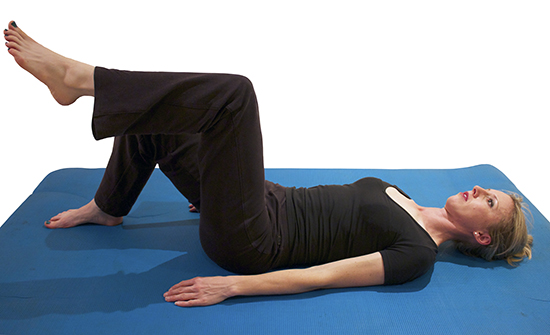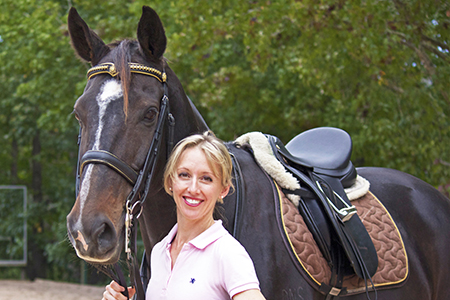In part one, we looked at how to find blockages in your back and what to do to help get rid of them. In part two, we are going to look at an exercise that really hones in on the core.
We already discussed what the core is, and ways to switch it on. Now we will get it to activate and remain switched on while we move other parts of our body. The core supports and controls the pelvis and spine and is the centre of your world when you ride. It is from this base that the torso stretches up tall, creating a light seat and from which the legs stretch down and long. It is your connection to your horse and it needs to be able to remain engaged and to continuously adjust to the changing environment that is your horseís back, so that you may remain balanced and as little a hindrance to him as possible. Your pelvis is also the place where you begin your aids for such movements as circles and lateral work, therefore good control of the pelvis via the core is essential.
Toe taps gets the legs moving while the body remains still and in a neutral position. This exercise will also bring awareness to your hips and waist and reduce the chance of collapsing a hip when on the horse. If you collapse one hip or the other whilst in the saddle, you will not be sitting equally on both seat bones and your horse will be able to control where your weight is, rather than you controlling your own position. This may result in such situations as being pushed to the outside of the saddle when riding a circle or the hips falling backwards and behind the movement of the horse, which would result in him losing the engagement of his hindquarters. An effective core will allow your lower back to be free to swing with the horse rather than be constricted and blocked, which could lead to lower back pain or injury.
During this exercise, you may notice one side is easier than the other. Do a few extra repetitions on the side that is more of a challenge to correct this imbalance.
 The Set Up
The Set Up
– Find neutral spine*, lying on your back with knees bent, feet and knees hip-width apart. You will have a small space under your lower back and all the vertebrae of your mid-back and ribs will be settled and heavy against the floor.
– Switch off your outer muscles, relaxing your hamstrings and calves a little.
– On an in breath, using the lateral breathing* method, switch on your core* by imagining the low abs melting inwards towards your spine and lifting up gently through the pelvic floor. When breathing, imagine filling up your lungs completely, including the sides and back, not just the front. The shoulders remain relaxed and still.
 Instruction Of Move:
Instruction Of Move:
– On the out breath, float one leg up so that the knee and hip form a 90 degree angle and your lower leg is parallel to the ground
– Breathe in and lower the leg
– Repeat with the other leg
Visualisations:
– Legs resting on a coffee table
– Feet resting on thin ice
– No muscles in legs. Make them light and floating with the work coming from the core.
– Tail bone is an anchor
– Ribs remain relaxed to floor
– Chest is wide and relaxed to encourage good breathing
– Abdominal muscles are scooped in, feeling as if they are attached to the spine
Watch Out For:
– Feet pushing too hard into the floor
– Flaring ribs
– Flaring knees. Keep them hip width
– Using hip flexors too much so that the core cannot activate sufficiently
– Doming stomach. Keep your stomach muscles magnetised towards your spine
– Movement from knees, not from hips
– Loss of neutral spine
– Tight shoulders
– Pelvis twisting

 Variation:
Variation:
You can make this exercise a little more difficult by starting with both legs in a double knee fold and touching one foot down to the ground and back up, then repeating with the other leg. You may even want to try either one or both arms off the ground while you execute the movement. However, before progressing to these variations, make sure your neutral spine is secure with a correctly activated core.
What not to do:
Notice how I have domed my stomach. I have also lifted my ribs off the floor whilst trying to keep my shoulders relaxed down. This has created unnecessary stress in my neck and I have lost my neutral spine.
Glossary
Neutral Spine: This is the shape of the spine when all the vertebrae are stacked one upon the other in alignment. The spine is concave in the lower back and the neck. These natural curves allow for good shock absorption. This is what we term a neutral spine position and we want to maintain this alignment when we ride.
Core: Your core is made up of some very deep muscles that help support your structure. They form a type of box in your lower abdomen. The top of the box is the diaphragm, the sides are formed by the internal obliques, and at the back is the multifidus which supports the vertebrae. At the front is the transversus abdominis and on the bottom is the pelvic floor. Thatís a lot of muscles to think about, so we focus mainly on the transversus and pelvic floor. Good breathing techniques will help take care of the diaphragm and correct exercise technique will support healthy obliques and multifidus. There are many ways to switch on the core, but the best way is to use imagery. Think that you are gently tightening a hipster belt, drawing up a pelvic elevator, stopping the flow of urine or melting your lower abs into your spine.
Lateral breathing: This is style of breathing where we breathe in through the nose and out through the mouth. It helps support the core. Think of filling up the lungs without losing the engagement of the core or lifting the shoulders up. Remember to breathe into the sides and back of the lungs, not just the front. Donít forget, if youíre not used to good breathing techniques, the diaphragm and the intercostal muscles that control the rib cage will need time to learn to work properly, just like any other muscle.
This article first appeared in the July 2012 issue of THM.





